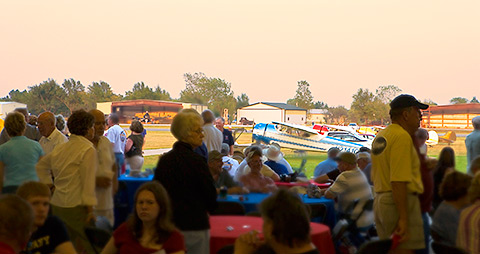Field of dreams
Welcome to 1K1, where you're a part of the family
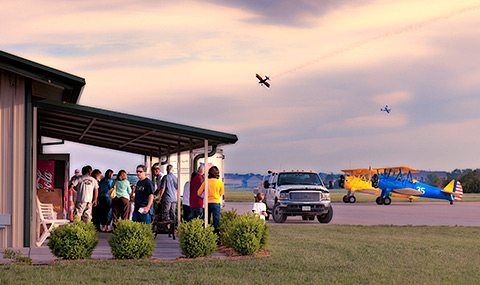
General aviation businesses are high-risk propositions in all seasons. But when an economic hurricane such as the recent credit crisis spawns a collapse in the housing market and a precipitous drop in general aviation manufacturing, a residential airpark near GA’s epicenter would seem doomed.
Yet Lloyd Stearman Field—a privately owned, public-use airport in tiny Benton, Kansas, just outside Wichita—is succeeding despite the broader financial devastation and its own seemingly disastrous timing. During the seven years since several partners—all biplane owners and pilots—bought a then-dilapidated airfield, the number of airplanes based there has swelled to 145 from 27; the runway has been widened and lengthened (twice) to 5,100 feet; new hangars have been built; sales of condominium hangars and private homes are solid; and a new airport restaurant with an outdoor stage for live performances has become a vibrant cash cow.

“I saw a great deal of potential in this airfield even when it was an eyesore,” said Dwayne Clemens, 44, a former Hawker Beechcraft test pilot and current Stearman Field owner who manages several airport businesses there with wife, Julie, and son Alex. “I thought cleaning up the airport and improving it would be fun, and it was the right thing to do for aviation. But it’s turned into much more than a hobby to keep me busy.”
High-definition TV screens on the walls at the Stearman Café & Grill show an endless loop of inspiring flying scenes from DVDs such as One Six Right and Big Rocks and Long Props. On sunny afternoons, families and friends fill the outdoor patio that offers an unobstructed runway view, and musicians perform on the outdoor stage on warm evenings. Visitors can learn to fly at Stearman Field and go for rides in vintage aircraft, including a Piper J–3 Cub and a Stearman PT–17.
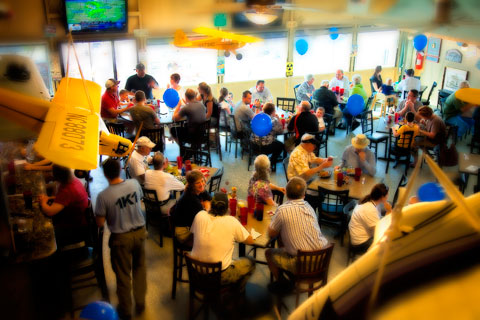
The restaurant opened in January 2010 and serves hamburgers and beer in what used to be a crumbling terminal building. The restaurant itself was an afterthought in the airport’s development plan but has turned out to be a one of its biggest draws. The restaurant brought in more than $700,000 in revenue during its first full year of operation, and it only came into being because Clemens couldn’t ignore the demand any longer.
“I used to cook breakfast for pilots on Sunday mornings in a little kitchen area in the corner of a rickety old building,” said Clemens, a ruddy, plainspoken pilot who serves as the airport’s jack of all trades. “It became a sort of Sunday-morning tradition, and before long we had 50 people coming by for breakfast. It finally occurred to me that, maybe, just maybe we ought to build a restaurant.”
Avgas is available at self-service pumps (as well as from a truck), and prices are typically about $1 a gallon less than surrounding airports. Hangar rent is as low as $100 a month.
Clemens says the relatively low fuel prices draw pilots from throughout the region, and those who visit patronize other airport businesses such as the restaurant and an aircraft maintenance facility.
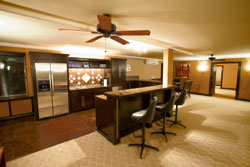 “We make it a point to keep our fuel prices down because lower fuel prices get people flying and keep them flying,” he said. “There’s not much profit in fuel sales for us. But the people who come here for fuel also buy burgers, and they’re more likely to get their annual inspections done here. A few have even bought property here.”
“We make it a point to keep our fuel prices down because lower fuel prices get people flying and keep them flying,” he said. “There’s not much profit in fuel sales for us. But the people who come here for fuel also buy burgers, and they’re more likely to get their annual inspections done here. A few have even bought property here.”
A gated community of single-family homes with attached hangars is featured on brochures for Stearman Estates. Several homes are under construction, and the largest is an 8,000-square-foot mansion with a cavernous 7,000-square-foot hangar.
Mike Filucci, an airline pilot based in Dallas, Texas, and wife, Julie (former AOPA Pilot technical editor), were drawn to Stearman Field when Julie joined Cessna in Wichita. Their 2,300-square-foot home and hangar were finished this spring after seven months of construction.
“Our hangar [at 3,300 square feet] is bigger than our house—so we’ve got our priorities straight,” Filucci said. Kansas wasn’t on his “top-10 list” of places to build a home, but the people who live and play at Stearman Field won him over.
“Aviation people tend to be multi-talented, interesting, and accomplished in many areas,” he said. “They’re artists and musicians and entrepreneurs of all stripes, and they’re just fun to be around. The pace of life here is slower than the East Coast, and that’s an adjustment. Midwest people tend to be friendly, helpful, kind, and considerate. And since just about everything here costs less, living here is almost like getting a raise.”

The most popular living spaces at Stearman Field are hangar condominiums—boxy metal buildings large enough to hold several single-engine airplanes at a time, and which also contain 3,200 square feet of living space. The asking price for a new hangar/condo is $350,000, and Clemens said he wishes he had more runway frontage on which to build them.
Clemens sometimes serves as a construction manager for hangar/condo buyers at Stearman Field, and new residents mean more demand for airport businesses. “Our maintenance facility is busy just about all the time just doing annual inspections on aircraft that are based here,” he said.
Those aircraft include piston singles and twins, helicopters, and at least one turboprop—and jets occasionally drop in for discount fuel. But resident tastes lean toward vintage and sport aircraft, and there are currently nine Stearman biplanes based here, a fact that seems appropriate since thousands of the iconic biplanes that Kansas native Lloyd Stearman designed were built in Wichita. (The airfield itself has no official connection to the Stearman family, however.)
When they’re not at the airport, Stearman Field owners Dwayne and Julie Clemens fly a corporate jet together. Converting a run-down building into a sparkling, aviation-themed restaurant draws pilots and airplane watchers throughout the region. A recent fly-in breakfast hosted many enthusiasts on a beautiful spring day.
There was no shortage of GA airports before Stearman Field came into being. Col. James Jabara Airport (AAO) is a scant five nautical miles away, and Wichita International Airport (ICT) is just 17 nm. But aviation businesses at those airports tend to focus on corporate clients, not hobbyists. Stearman Field draws and welcomes aviation enthusiasts, whether they are pilots or not.
“There aren’t many airports where families can come and let their kids see airplanes taking off and landing close up,” Clemens said. “This place on a sunny weekend is really an airpark. People come to hang out and play with their toys.”
Retired Cessna CEO Jack Pelton and his wife, Rose, own a Stearman Field condo hangar where they keep a vintage Cessna 195 and a 162 Skycatcher.
A downfall of some residential airparks is acrimony among pilots who take issue with each other, the way their neighbors fly, or the kinds of homes and hangars they build. Stearman Field avoids such pitfalls through its own form of benign dictatorship. There are no rule-making committees or complex bylaws. Restrictive covenants are posted on the website, and Clemens says the rules for getting around at the airport are simple and easy to follow.
“Don’t drive on the grass,” he said, “and stay off the runway unless you’re in an airplane. As long as people remember those two things, we get along just fine and everything’s OK.”
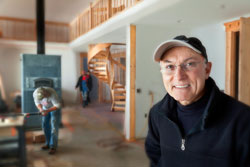 Getting Stearman Field and its associated businesses to this point, however, has required a huge amount of sustained effort. Knocking down decrepit buildings and piles of junk meant hauling out 25 tractor-trailer loads of debris. Enlarging the runway and improving the taxiways and ramp cost about $1 million, and a large percentage of those funds came in the form of state aviation grants.
Getting Stearman Field and its associated businesses to this point, however, has required a huge amount of sustained effort. Knocking down decrepit buildings and piles of junk meant hauling out 25 tractor-trailer loads of debris. Enlarging the runway and improving the taxiways and ramp cost about $1 million, and a large percentage of those funds came in the form of state aviation grants.
Clemens says Stearman Field owners reinvest almost 100 percent of the proceeds from real estate sales and other airport ventures to improve the facility. The original airport was 34 acres, and the owners purchased an adjoining 160 acres and 35 home lots. About 90 percent of Stearman Field’s 39 condo lots and 40 percent of the home lots have been sold to date. (Home lots are priced at $50,000 and hangar lots are $35,000.)
Clemens and his family do everything from bookkeeping to cutting the grass on Stearman Field’s turf runway—and they hold down other jobs, too. Dwayne and Julie manage a Hawker 800 jet for a private owner and fly it together on domestic and international trips.
“We’re going to fly it to Cabo [San Lucas] tomorrow for five days, and that’s going to seem like a vacation,” he said. “But what we do at Stearman Field usually doesn’t seem that much like work. There’s a lot to do, and most of it is thoroughly enjoyable.”
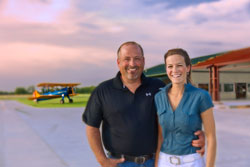 The couple lives in a 4,000-square-foot home at midfield, with picture windows facing the paved north-south runway. Their son Alex lives in a condo/hangar on the other side of the strip and runs the flight school and scenic-ride business.
The couple lives in a 4,000-square-foot home at midfield, with picture windows facing the paved north-south runway. Their son Alex lives in a condo/hangar on the other side of the strip and runs the flight school and scenic-ride business.
Clemens likes to point out that while the couple flies for a living, making the airpark successful has become a central part of both their lives.
“We make our money flying,” Clemens quips. “We spend it at Stearman Field.”
E-mail the author at [email protected].
